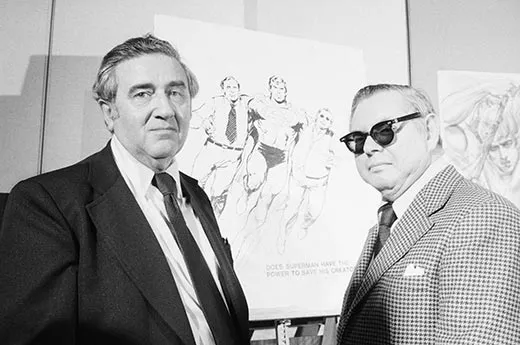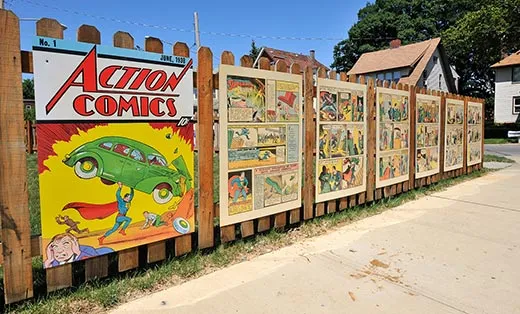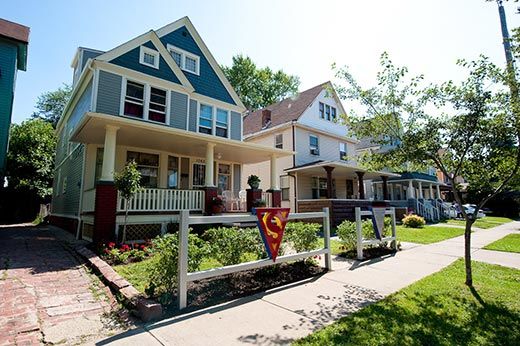Cleveland, the True Birthplace of Superman
Comic book fans and city activists hope that people think of the Ohio city, and not Krypton, as the home of the Man of Steel
/https://tf-cmsv2-smithsonianmag-media.s3.amazonaws.com/filer/Superman-Jerry-Siegel-house-631.jpg)
With the departure of basketball star LeBron James earlier this summer, Cleveland has lost a superman. James was going to save the city as its native son, rescuing Cleveland from its economic woes. His image literally loomed over the city’s residents, on a multistory billboard that dominated downtown. Now, though, with James leaving the Cavaliers for Miami, Cleveland can focus on its first Superman—the one born on Krypton. In the past, the city has not given Clark Kent and his alter ego much attention, even though he was invented by two boys on Cleveland’s East Side. But that is changing, as the city is slowly beginning to recognize its role in creating the superhero who stood for “Truth, Justice, and the American Way.”
In 1933, Jerry Siegel and Joe Shuster dreamed up the comic strip hero with superpowers. Both boys were from immigrant Jewish families and lived down the street from each other in Glenville, then a booming, overwhelmingly Jewish, middle-class neighborhood, with kosher markets selling Yiddish newspapers on nearly every street corner. At the time, Cleveland was the fifth most populous American city, and a forward-thinking one at that, being the first to install public electricity and trolleys.
Siegel’s father first arrived in Cleveland as a sign painter, but he soon left that profession to open a haberdashery in a less prosperous part of town, only to die from a heart attack when robbers entered his store. According to Gerard Jones’ indispensible book Men of Tomorrow: Geeks, Gangsters, and the Birth of the Comic Book, the Siegel family was told that he had been shot in the chest. (Whether this incident was the inspiration for a bullet-proof superhero is unknown but seems plausible.)
Shuster’s family was not as wealthy as Siegel’s, so Joe, an obsessive artist, often sketched on tissue and other scrap paper. Both teenagers were awkward around girls, timid and obsessed with the pulp magazines of the day. According to Jones, Shuster would visit newsstands and pore over the magazines, particularly Amazing Stories, and then recreate them at home.
Judi Feniger, executive director of the Maltz Museum of Jewish Heritage, notes that Siegel and Shuster both exemplify the Cleveland immigrant story, as children of parents who may not have spoken English. They had a “working-class ethic that is particularly Cleveland, and particularly Glenville,” she says. In 2008, the museum hosted the exhibit “Zap! Bow! Bam!” about the creation by Jewish immigrants of Superman and other comic book heroes.
Siegel and Shuster met in high school; Siegel was the ambitious one. After the two came up with the idea of a comic book hero, he took control of the venture and concocted a romantic origin story for Superman. One sleepless summer night, as retold by Jones in his book, Siegel was struck by an inspiration: “I hop out of bed and write this down, and then I go back and think some more for about two hours and get up again and write that down. This goes on all night at two-hour intervals. [The next morning] “I dashed over to Joe’s place and showed it to him…. We just sat down and I worked straight through. I think I had brought in some sandwiches to eat, and we worked all day long.” By that night, the first weeks of comic strips were completed.
Whether or not this “Eureka!” tale is true (In Men of Tomorrow the author questions its accuracy), Siegel and Shuster did write the first Superman strips from their houses, and continued to do so even after they graduated from high school and became famous. (Siegel eventually moved out of the house in Glenville into one in the upscale neighborhood of University Heights, but began spending most of his time in New York, where he and Shuster eventually relocated.)
In 1938, they sold their hero to DC Comics for $130, which took the rights to the character. Superman soon became one of the best-known characters in the world, but Siegel and Shuster received no royalties or benefits from their creation. Unable to support themselves with their comic, they took other jobs; by the 1970s, Siegel was working as a mail clerk. In 1975 a lawsuit they filed against DC Comics was settled in their favor, giving Siegel and Shuster both money—$20,000 a year each for the rest of their lives—and credit. Now the phrase “Superman created by Jerry Siegel and Joe Shuster” appears on all Superman-related products.
Shortly after Siegel and Shuster died in the 1990s, a similar struggle for recognition of Superman’s creators took place in Cleveland. Michael Sangiacomo, a comic books critic and a reporter for Cleveland's The Plain Dealer, called on the city to honor Siegel and Shuster. Nothing came of it. Every few years he would trot the idea out again, writing an article calling on Cleveland to honor the pair. “I pointed out that the Siegel house was here [the home of Joe Shuster had been torn down], and that is the home of Superman, and the city should do something.”
In his will, Siegel asked that half of his ashes be donated to the city of Cleveland; his widow also wanted to donate some of his belongings to the city, such as his typewriter. She visited Cleveland to find a home for them, and Sangiacomo escorted her around town. “Nobody wanted them,” he remembers. “It was a low point. I felt horrible for her and mad at the city.”
Meanwhile, the old Siegel house was falling into disrepair, as was Glenville. Kimberly Avenue, where Siegel lived, has few longtime residents—there were 11 abandoned houses on the boys’ block alone—but Hattie and Jefferson Gray, the couple who lives in Siegel’s old house, have owned it for decades.
Visiting comic book writers and fans often asked Sangiacomo for a tour of the Siegel home, and he would drive them by the place. Two years ago, he took best-selling thriller and comic book writer Brad Meltzer by the house, and the pair was invited inside. After seeing the condition of the interior, Sangiacomo says, “I realized we had to do something.”
Sangiacomo and Meltzer decided to raise money to restore the house. Melzer uploaded a video of himself at the house that went viral. He followed by sponsoring an auction of comics-related art, raising over $100,000 in the process. Sangiacomo and Meltzer formed the nonprofit Siegel and Shuster Society, and asked the Glenville Community Development Corporation to take charge of restoring the house, in partnership with the Grays.
According to Tracey Kirksey, executive director of the Glenville CDC, her group offered to buy the home from the Grays. But “they have lived there for over 20 years and were not interested in selling the family home to us.” Before the Glenville CDC proceeded with repairs, though, the Grays agreed to give the group first right of refusal should they decide to sell.
The Glenville group took charge, hiring contractors to repair a leaky roof, redo the siding, improve the landscaping, and paint the house Superman blue and red. A plaque was installed honoring Siegel. Written by Sangiacomo and Meltzer, the plaque says that Siegel “was a teenaged boy who lived here during the Great Depression.” “Jerry wasn’t popular,” it continues. “He was a dreamer, and he knew how to dream big.” The plaque ends with the aphorism, “[Siegel and Shuster] didn’t just give us the world’s first super hero.…They gave us something to believe in.”
Proud of the house’s historical importance, the Grays participated in the 2009 ceremony to unveil the plaque, which was affixed to a steel fence (for the Man of Steel) with a large red Superman shield at its center.
Where the Shuster house once stood, the Glenville group installed another fence with six poster-size reproduced plates of the first appearance of Superman in Action Comics #1. A seventh poster proclaims, “On this site once stood the home where Superman was turned from words into pictures.… With the creation of Superman, these two friends showed the world that the most ordinary of us can turn out to be the most heroic.”
The city finally took notice. Tracey Kirksey had been trying, like Sangiacomo, to have the city tear down abandoned houses, “but it never seemed to be a priority.” With the Siegel house restored, the city has now demolished seven houses on Kimberly Avenue, Kirksey says, and is now looking to “green-up the lots and replace those houses with new developments.”
The Siegel house is still owned by the Grays and not open to the public, but Sangiacomo hopes it may one day become a museum. “I’d love to turn it into a mecca for comic book lovers from across the world, into a place where people visiting the city could come and walk through it and see where Jerry created Superman, to turn it into something Cleveland could be proud of.”
Kirksey has more ideas, too, such as a permanent sign at the Cleveland airport, or a Superman statue. The best spot for such a statue? Perhaps downtown, underneath the place where the billboard of LeBron James once hung.



